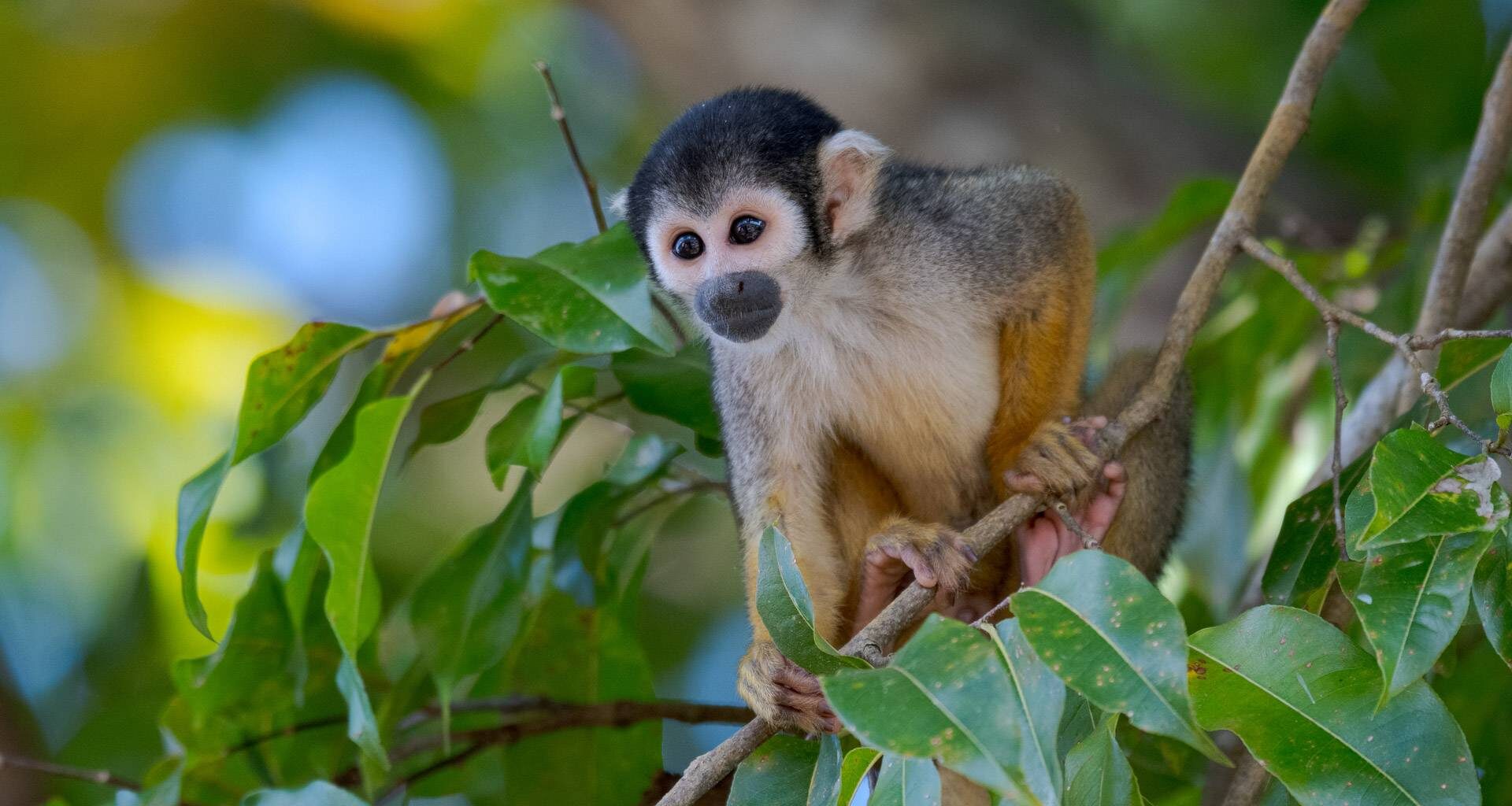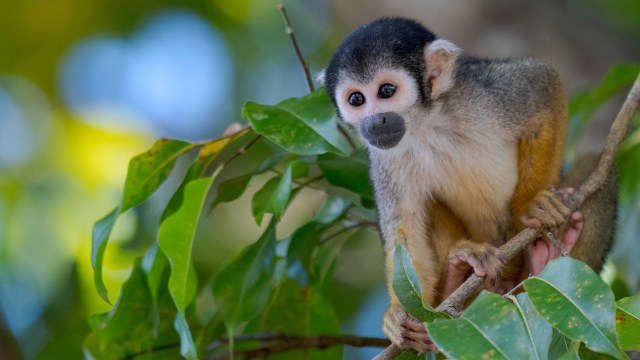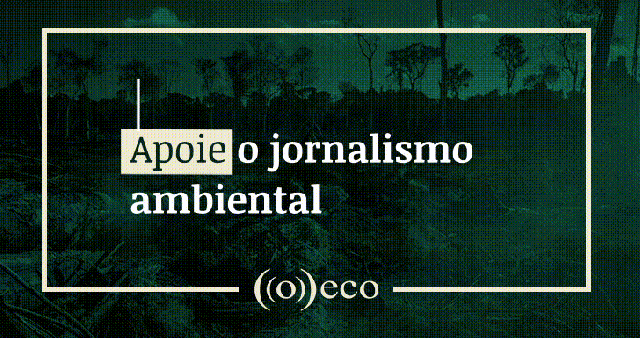In the very heart of the Amazon, among broad rivers and still-standing forests, lives a small monkey that could vanish within the next 30 years. The tragic irony of the black squirrel monkey is this: despite living in one of the most pristine portions of the rainforest, protected by the Mamirauá Sustainable Development Reserve, it is completely vulnerable to climate change. With floods and droughts growing more extreme, the flooded forests the monkey depends on for survival are under threat, and this uniquely Brazilian species seems destined to disappear before our eyes.
This monkey inhabits only a small portion of low-lying floodplain forest, an ecosystem governed by the pulse of the rivers and flooded for much of the year. The black squirrel monkey’s (Saimiri vanzolinii) vulnerability comes from its limited range – just 870 km², about half the size of London, and the smallest known distribution of any primate in the Americas.
The species is confined to only three islands along the Solimões and Japurá rivers in Amazonas state, northern region of Brazil. The largest one lies within the southern edge of the Mamirauá Reserve, while the other two are smaller and are outside of the protected area.
Literally stranded in its habitat, this Amazonian primate may be one of the first species to vanish due to the impacts of the climate crisis. Scientific projections show its current home will almost entirely lose the conditions needed to sustain the monkey by 2050.
Climate modeling, led by Rafael Rabelo, head of Research and Monitoring at the Mamirauá Institute for Sustainable Development, considered two scenarios for 2050 and 2070. One is optimistic, assuming strict global reductions in greenhouse gas emissions that accelerate global warming. The other more pessimistic – and perhaps more realistic – follows a “business-as-usual” path of emissions.
“What’s striking about this species,” says Rabelo, “is that regardless of the year or the scenario, its risk of extinction remains very high. In every case we projected almost 100% loss of suitable habitat in the areas it currently inhabits.”
Even in the optimistic scenario, by 2050 the monkey is expected to lose 99.8% of its habitat, leaving just 0.2% or 1.74 km² to survive – about half the size of Central Park, in New York City.
If any populations endure, by 2070, conditions improve only slightly in this scenario with “only” 92.8% of its current range still being unsuitable.
In the pessimistic scenario of emissions, 90.7% of habitat its lost by 2050, and by 2070 the projection reaches 100%, with a complete loss of suitable forest for the black squirrel monkey.
Losing environmental suitability means that the habitat factors that sustain the monkey will collapse or shift.
The changes in rainfall, river dynamics, and more frequent extreme events will directly affect fruiting cycles and more sensitive plants, as well as insect populations, undermining some of the main food supplies for the monkey. Severe droughts will also increase heat stress and water scarcity for the species.
The monitoring of primates and other mammals in the Mamirauá Sustainable Development Reserve also uses canopy camera traps. Videos: Mamirauá Sustainable Development Institute
In a world where climate shifts slowly and naturally, the species could have a chance to adapt to the new conditions or migrate to better areas. But in the fast-paced Anthropocene, driven by human activity, its odds are slim.
“Climate change is a sum of effects,” says researcher Anamélia Jesus, from Mamirauá Institute for Sustainable Development. “It’s not just global warming or a drought. The entire water cycle drives not only forest dynamics but animal reproduction, which is tied to food availability, like fruits. All of this is being disrupted.”
The warning about the future of the species caused S. vanzolinii to be uplisted in the latest national assessment by Instituto Chico Mendes de Conservação da Biodiversidade (ICMBio) – federal agency responsible by protected areas and fauna management and risk evaluation – going from Vulnerable to Endangered to the risk of extinction.
The assessment also warns of the impact of above-average flooding. “Hydrological models of changes in the flooding regime predict that the entire range of the species could be flooded in the future,” details the ICMBio analysis, signed by a team of researchers from different institutions.
The Species
The black squirrel monkey (Saimiri vanzolinii), was only described to science in 1985 by primatologist José Márcio Ayres, who also created the Mamirauá Sustainable Development Reserve. Its scientific name honors Paulo Vanzolini, a zoologist and composer who mentored Ayres and his partner during several trips to the region. Its common name refers to the characteristic that easily distinguishes this species from others: the black on the top of the head, instead of the typical brown tone, contrasting with the face and belly. On their hands, golden gloves extend up to their elbows. About 30 centimeters long, they are diurnal animals that live in large flocks of up to 200 individuals.
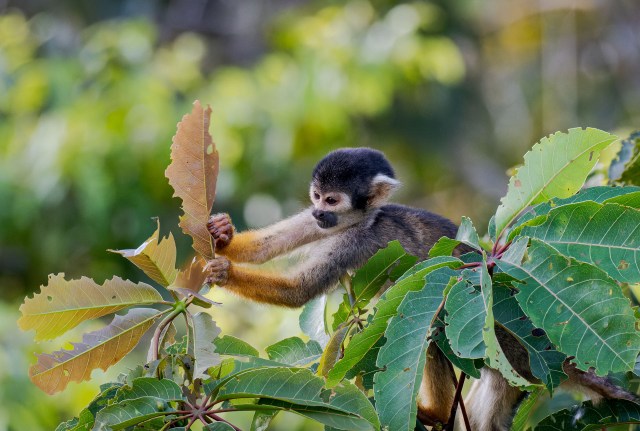
The black squirrel monkey feeds mainly on fruit and insects. Photo: Miguel Monteiro
No place to stay, nowhere to go
The climate modeling was completed in 2022 and is in the final stages for publication. To project the distribution of the black squirrel monkey, the environmental and climatic conditions suitable for the species were considered, together with greenhouse gas emission scenarios recognized by the Intergovernmental Panel on Climate Change (IPCC).
“We used different types of data. Biological data on species occurrence, which we collected ourselves in long-term research conducted by the Institute. Environmental variables directly and indirectly relevant to species, such as soil, topography, and vegetation. And climate models predicting future climate change,” explains Rafael Rabelo, the researcher responsible for modeling.
By cross-analyzing this data, an initial model is constructed that indicates the species’ preferred areas, which are environmentally and climatically suitable today. “Once this model is validated, we keep the same environmental variables, replacing the climatic variables with those of the future, and thus we are able to investigate where the conditions suitable for the species will be in the future,” adds the coordinator of the Mamirauá Institute.
As a result, in addition to quantifying the loss, the researchers were able to estimate potential gains in suitability. In other words, they identified locations that, with climate change, are likely to become suitable for the survival of S. vanzolinii in 2050 and 2070. And they found that the region to the northwest of where the species occurs today will have better conditions for the species.
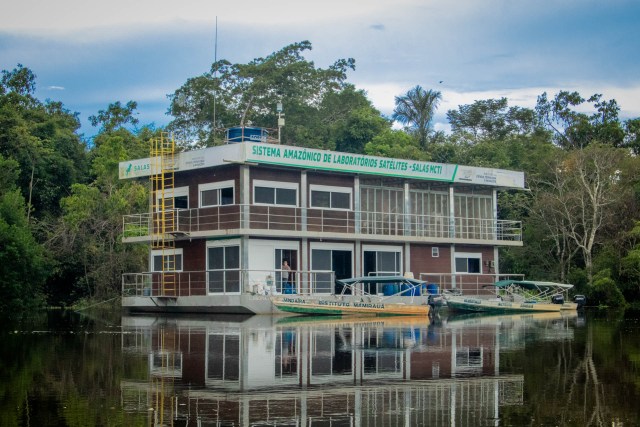
Floating platform serving as a base for researchers in the Mamirauá Sustainable Development Reserve. Photo: Duda Menegassi
However, the news is not exactly a solution.
This is because the portions of forest that will become suitable for the small black-headed primate already have an owner. More specifically, another species of squirrel monkey: the Saimiri macrodon. A relative of the same genus that occupies the same ecological niche and competes for the same resources.
“If we can assume that this species is able to migrate naturally, that is, to pursue these climatic conditions over time, we can have a glimmer of hope that the species may be able to persist. But these assumptions are very difficult to make. First, because climate change is occurring at a very rapid pace, so we do not know if the species will have time to respond. And second, because the place where the species will potentially find suitable climatic conditions in the future is where another species now exists, which would be a potential competitor,” Rabelo analyzes.
Unlike the black squirrel monkey, the Saimiri macrodon – commonly known only as “squirrel monkey” – has a wide distribution, more than 40,000 times greater than that of the vanzolinii, which includes two brazilian states Amazonas and Acre, and crosses national borders into the Colombian, Ecuadorian, and Peruvian Amazon. This suggests a greater ability to adapt to different environments than the more restricted Saimiri vanzolinii.
Even on the other bank of the Japurá River, there is also an owner and a different “rival” squirrel monkey, the Saimiri cassiquiarensis.
“We are literally watching a species go extinct,” Rabelo admits. “And perhaps we shouldn’t even intervene, because trying to reverse its extinction could create new ecological imbalances. The uncertainties are huge.”
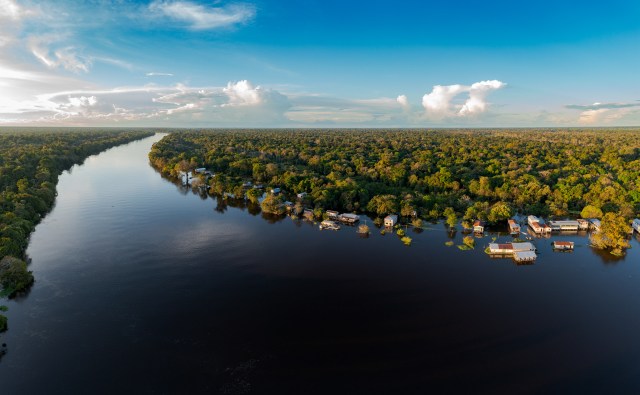
The community of Boca do Mamirauá, at the entrance to the reserve. Photo: Miguel Monteiro
A monkey facing the end of the world
Monitoring the effects of climate change on flooded-forest fauna is a key goal of the primate census launched this May in the Mamirauá Reserve. ((o))eco’s reporter went to the municipality of Tefé, Amazonas state, to follow the beginning of the survey in the protected area.
Armed with binoculars and trained ears, researcher Anamélia Jesus is the one responsible for the census. She is the one to alert. “There, it’s him”. I look in the direction she points, high up in a tree at least 30 meters away from us, and for a few seconds I see only leaves moving. My heart pounds. Suddenly, a silhouette. Even without being able to see the characteristic black head, there is no doubt, there is the Saimiri vanzolinii, with its small, slim, agile body and long, thin tail.
One, two, three… I see four of them moving from one tree to another. Having learned everything this story required, I am moved by the idea that I am standing before an animal that may no longer exist in thirty years.
In a single day in the flooded forest, I saw more than twenty individuals of the species. Each time the little primate appeared, two thoughts crossed my mind: how abundant the species is today, living without threats such as hunting or deforestation; and how fragile all this is in the face of a global and invisible threat that does not respect the boundaries of protected areas, such as climate change.
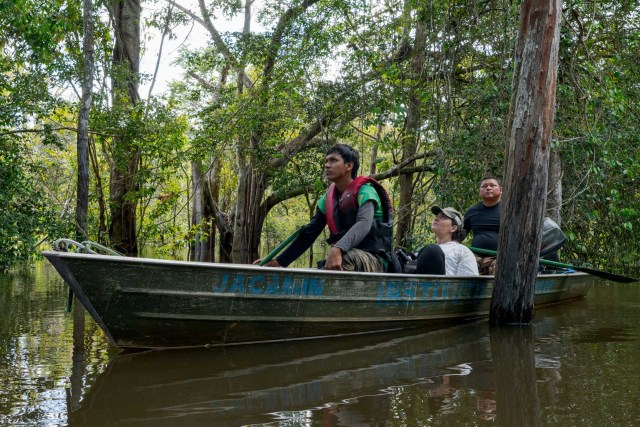
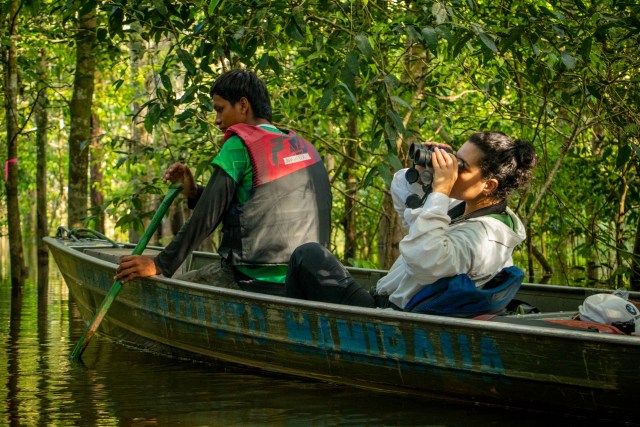
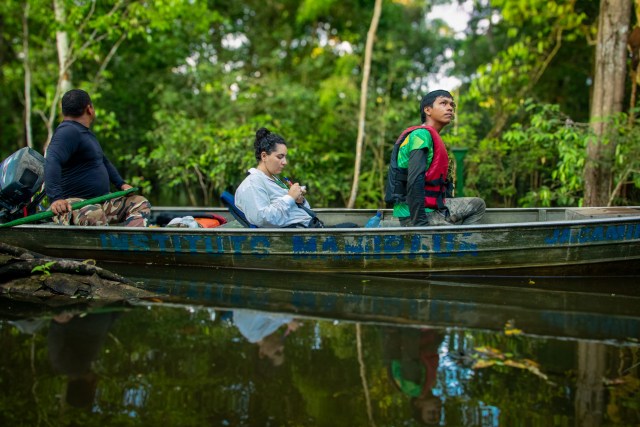
During the rapid census, researcher Anamélia Jesus observes and records encounters with primates. Photos: Duda Menegassi
I traveled with Anamélia Jesus along the Urucurana and Iuiry trails, which form the census circuit. At the end of May, at the peak of the flood season, the journey was made by canoe. The researcher led the way, accompanied by two field assistants. I was in a smaller canoe behind them, with the institute’s photographer, Miguel Monteiro, and one of the reserve’s most experienced assistants, Eziel, a resident of the reserve.
The work marked the beginning of the rapid census of primates in the Mamirauá Reserve, which will be carried out annually, both during the flood and dry seasons. In addition to the squirrel monkey, we found groups of the emblematic white uakari (Cacajao calvus), capuchin monkey (Sapajus macrocephalus), and red howler monkey (Alouatta juara).
The census follows the RAPELD method – Rapid Inventories in Long-Term Ecological Projects. The goal is to be able to quickly assess the presence of species in the protected area. There will be two campaigns per year, each lasting two days, at the peak of the flood and the dry season respectively.
“The idea is to understand the encounter rates [with species] over the years. And starting next year, we will cross-reference these encounters with environmental data so that we can also understand how these animals are distributed in this environmental gradient and have enough information to try to predict what may happen to them in the future,” says the researcher.
With each sighting on our trail, the researcher quickly jotted everything down in her notebook. There was information about the species sighted, the time of the encounter, the position and distance from the trail, the number of individuals, and even their sex, if she could identify it.
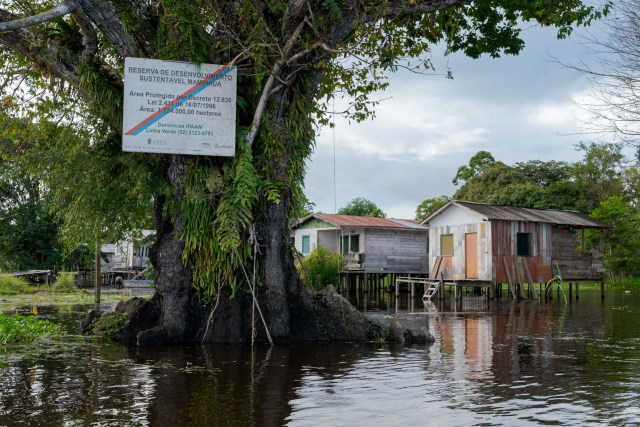 The Mamirauá Sustainable Development Reserve was created in 1996 and also helps protect the riverside communities that live there. Photo: Miguel Monteiro
The Mamirauá Sustainable Development Reserve was created in 1996 and also helps protect the riverside communities that live there. Photo: Miguel MonteiroThe squirrel monkey was the most common sight. In a single day, even with my untrained eyes, I saw at least seven groups and even spotted a mother with her baby. According to the researcher, the average is 6.3 encounters per day on each trail, or 1.3 encounters per kilometer. And a single group can have between 50 and 200 individuals.
These numbers do not fit with the announcement of imminent extinction, but they reinforce the vulnerability of this apparently healthy and abundant population.
Between 2009 and 2013, the Mamirauá Institute conducted a monitoring survey that found that the population of black squirrel monkeys was stable. Since then, no new studies have been conducted on the primate’s population status.
At the time, researchers estimated the population at around 400 individuals per square kilometer, which would correspond to around 350,000 black squirrel monkeys across the species’ entire range.
“At that time, in that location, the population was large and was not a source of concern, disregarding the climate issue. It is also important to highlight the effective role of the Mamirauá Sustainable Development Reserve in preserving the species,” points out Fernanda Paim, the researcher responsible for the monitoring between 2009 and 2013, currently a teacher outside of Amazon and away from the research.
The main problem, Paim emphasizes, is the species’ limited habitat, which leaves it vulnerable to any climatic and catastrophic events that may occur in the area. “Climate change is a reality, this is evident across the entire planet, and the Amazon is no different. The species will lose its entire habitat in the very near future. It may flood to such an extent that the species will have nowhere to go,” she comments.
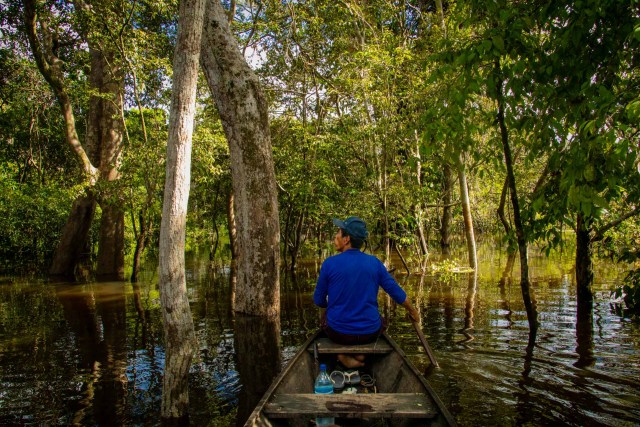
“Seu” Eziel, an experienced field assistant and resident of the Mamirauá Reserve. Photo: Duda Menegassi
A Domino Effect
“Fruit productivity in the region will be affected, as will that of insects, and this will directly impact the species, because we are talking about their diet. And in the long term, it will lead to a decline in the population. It’s not that the animals will die quickly, but they will experience stress, which will likely cause changes in the species’ reproduction rates and, over time, they will stop reproducing and become extinct,” explains Fernanda Paim.
It is calculated that floodplains cover about 700,000 km² of the Amazon Basin. And along the great Amazonian rivers, many areas of forest are regularly flooded along with the natural inundations. These places are called flooded forests, floodplain forests, and igapós.
In the Mamirauá region, the river level varies by an average of 11 meters between flood and drought.
The area where Saimiri vanzolinii occurs has a lower elevation, and naturally remains flooded for longer. Within this environment, the monkey prefers a more open type of forest, known as “chavascal”, which is found on more clayey and marshy soils that retain the water even during the dry season.
“As this area is more sensitive, with fewer tree species, it is subject to the effects of extreme droughts and floods, especially droughts. Because if you have an extreme event, it will affect precisely those plant species that are adapted to this seasonal condition of flooding and drought,” explains Rafael Rabelo, from Mamirauá Institute.
Climate extremes are becoming more frequent in the region. In 2023 and 2024, severe droughts even dried up stretches of the vast Solimões River. Compromising not only biodiversity but also the lives of riverside communities that depend on rivers for food, transportation, and access to basic services such as education and health care.
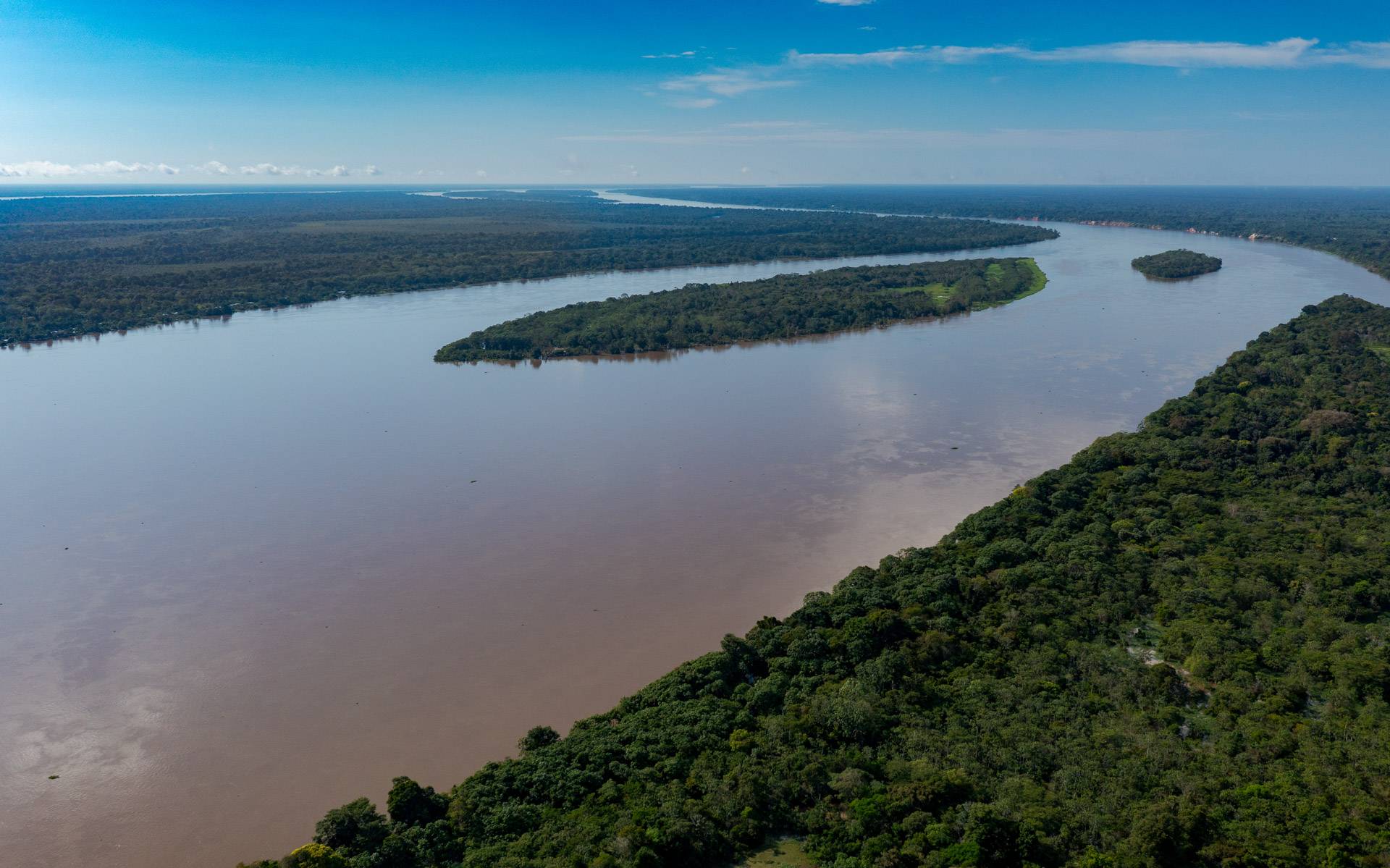
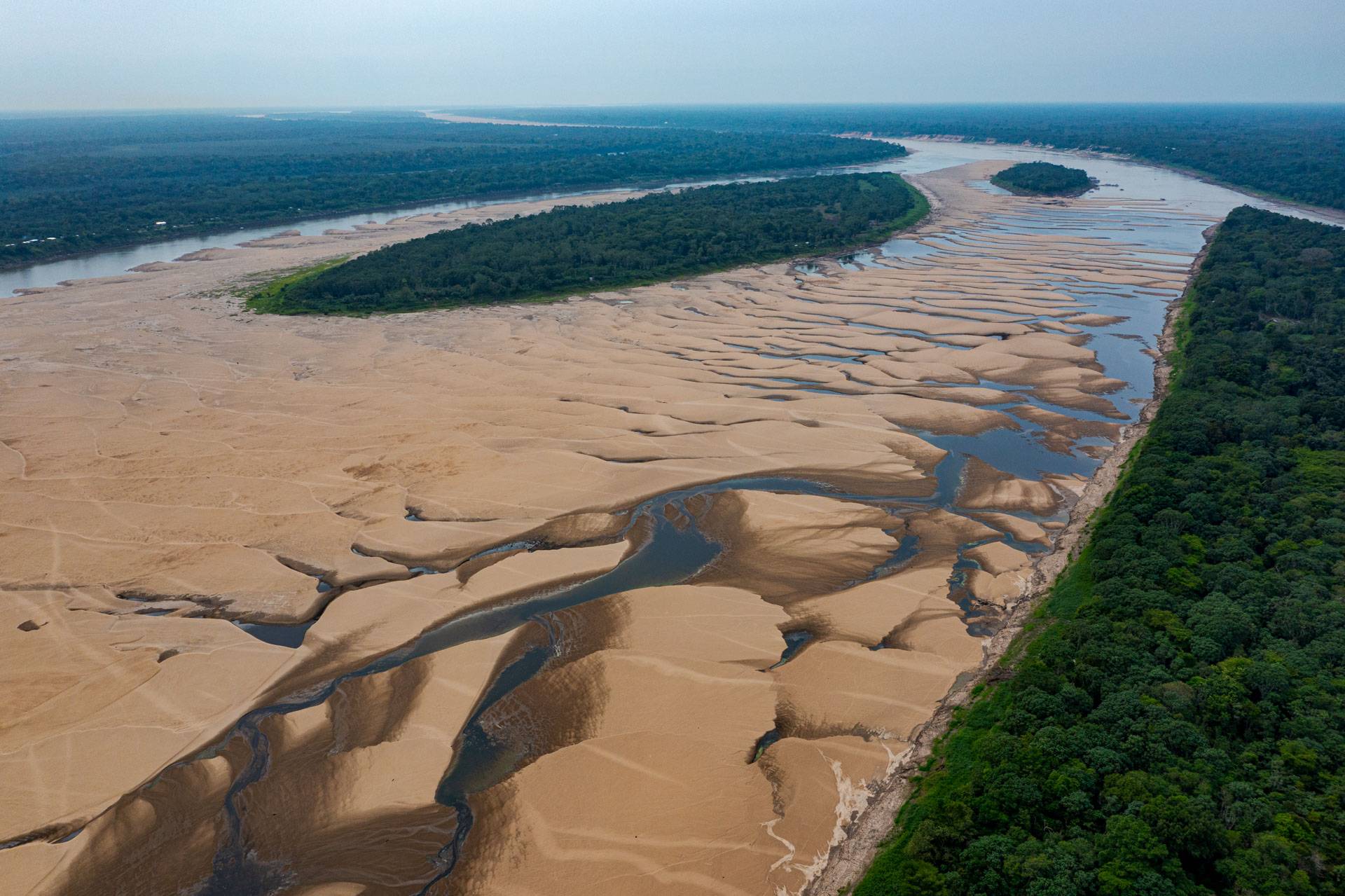
The Solimões River at two very different times: during the flood (2025) and the extreme drought of 2024. Photos: Miguel Monteiro
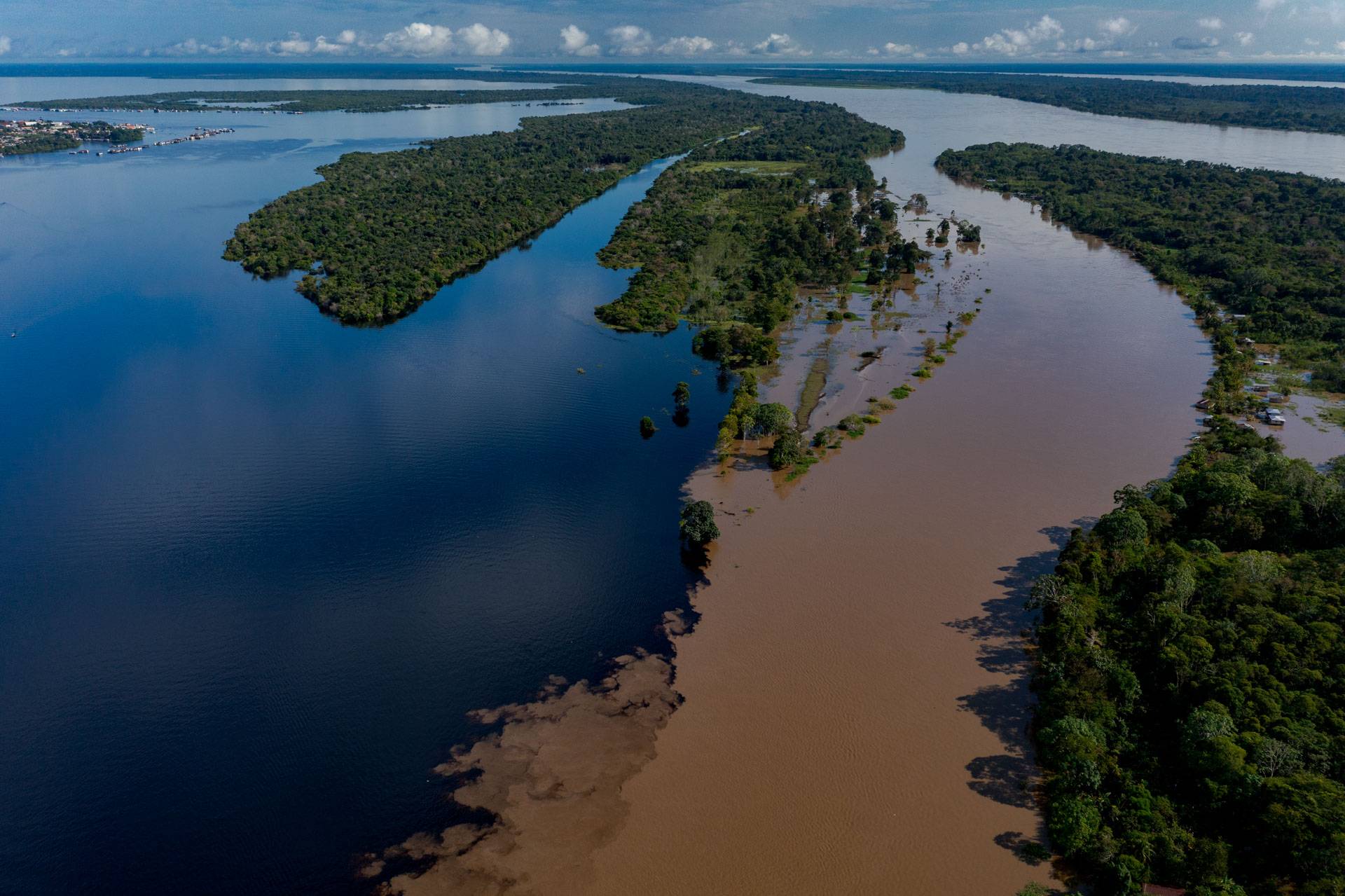
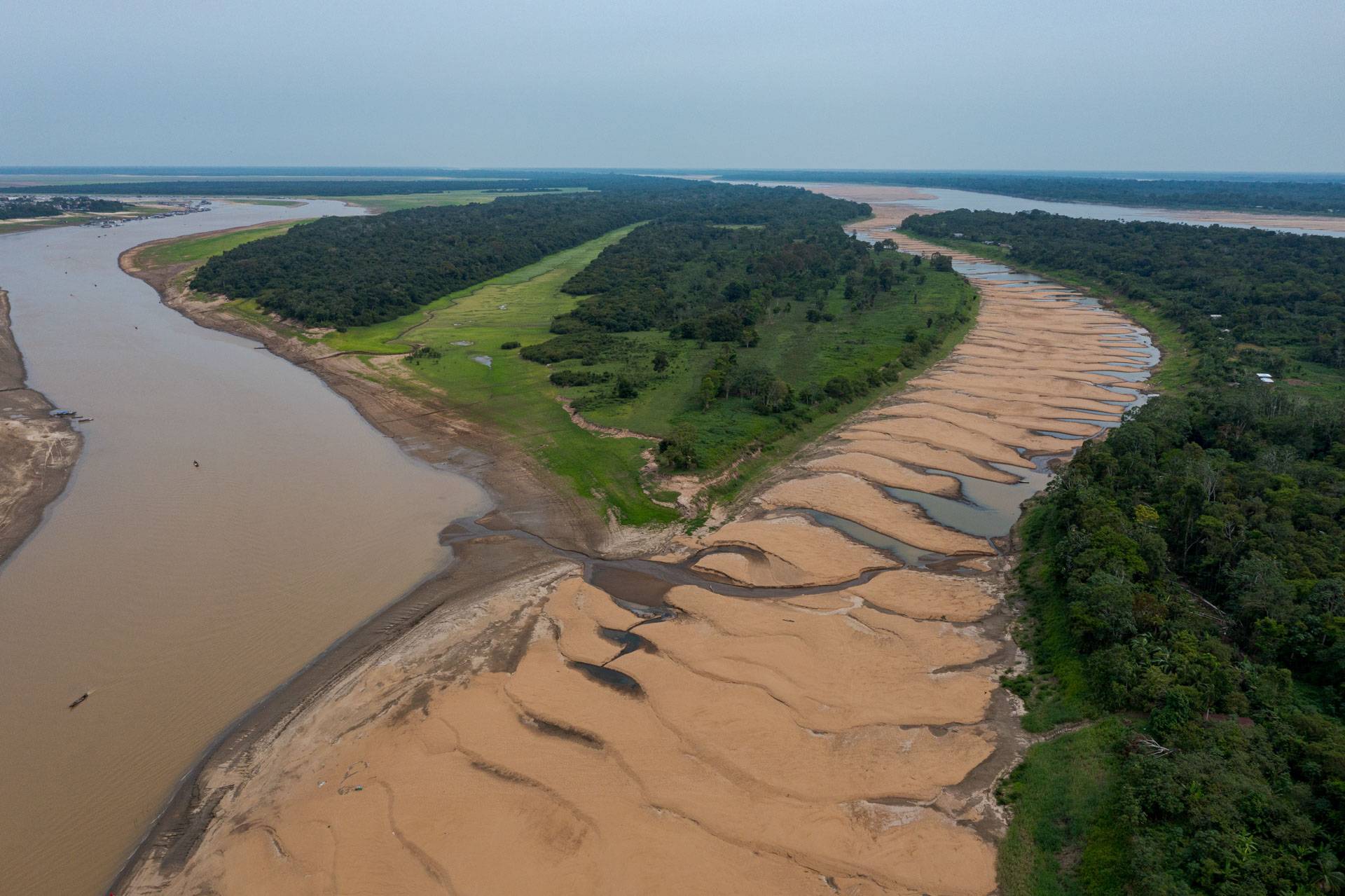
Near Tefé, Amazonas state, the Lake Tefé was also transformed by the extreme drought of 2024. On the left, the lake during this year’s flood. Photos: Miguel Monteiro
Environmental engineer and hydrologist Ayan Fleischmann, senior researcher at the Mamirauá Sustainable Development Institute and coordinator of the Research Group on Geosciences and Environmental Dynamics in the Amazon, explains that the climate emergency is not just about drought.
“The climate emergency manifests itself as a synergy of different disasters that sometimes occur simultaneously, sometimes in sequence. What we have seen in the Central Amazon in recent years is an acceleration of the hydrological cycle, with more extreme floods and more extreme droughts occurring,” he says.
There were extreme droughts in 2023 and 2024 in Manaus (AM), where the Solimões River meets the Negro River. And seven of the ten largest floods of the last century in the region have been recorded since 2009.
“But flooding is not just about the water level rising. It stays flooded longer, and environments that were not connected before become connected with the flooding. There is a change in the flooding pattern, and in the dry season, you have a very drastic reduction of the water surface. These are two different phenomena that will affect species in different ways. In vegetation, there are species that cannot tolerate such long periods of flooding,” he continues.
The researcher adds that there is also the phenomenon of weaker, below-average floods, which means that the floodplain forest does not flood, impacting many species. “The pirarucu fish nests in the floodplain forest, for example. If it does not flood for two years in a row, this can have cascading ecological impacts. And then there is temperature, which is another process. When air and water temperatures are higher. River dolphins die when the water temperature is too high. We saw this in Lake Tefé. Hotter air temperatures affect squirrel monkeys and other animals, as well as vegetation. There are several processes that happen in synergy,” adds Ayan.
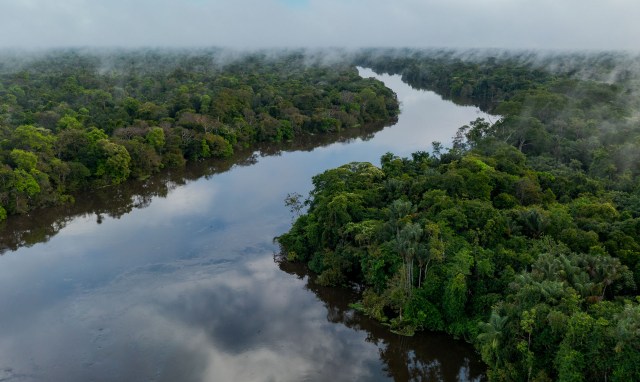
Flooded forests and their inhabitants depend on a close relationship with the water cycle, which is being compromised by the climate crisis. Photos: Miguel Monteiro
A canary in the coal mine
Far from being an isolated victim, the black squirrel monkey may be the “canary in the coal mine” of climate change. Whose death – or in this case, extinction – warns of a much larger problem that is only just beginning.
Although the modeling focused only on the species’ environmental preferences, it indicates significant changes in the portion of flooded forests on which not only the black squirrel monkey depends.
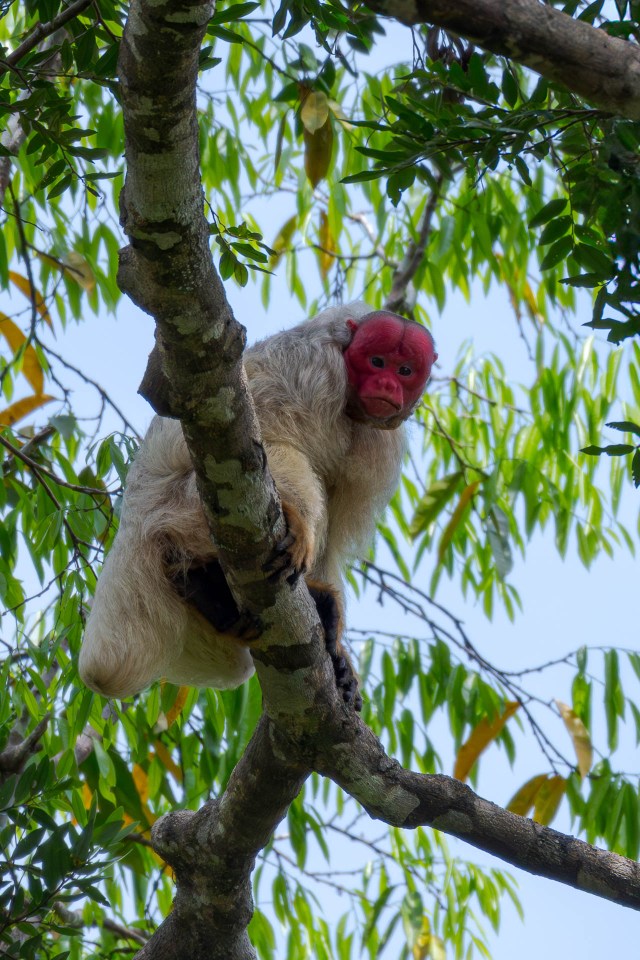 White uacari, another emblematic species of the flooded forest in Mamirauá. Photo: Miguel Monteiro
White uacari, another emblematic species of the flooded forest in Mamirauá. Photo: Miguel Monteiro“We have already noticed that in this part of the reserve, where environmental conditions are very different from those in adjacent regions, these changes represent a series of other things. S. vanzolinii ends up being a flagship species, or sentinel, for impacts that may affect other species that occur preferentially or exclusively in this region of flooded forests,” explains Rafael Rabelo.
The white uakari, an emblematic species for the creation of the reserve and owner of an unforgettable appearance (with a body covered in white hair, a red head, and short tail) is one of the species that survive exclusively in flooded forests.
The Mamirauá Reserve is home to significant portions of this type of environment and has a high rate of endemism, meaning a large number of species are found only within the protected area.
“Obviously, we can expect the impacts of these climate changes on some species to a greater or lesser extent, but the impacts will certainly not be limited to S. vanzolinii,” adds Rabelo.
A rescue plan for amazon primates
Saimiri vanzolinii is one of 13 threatened species included in Brazil’s National Action Plan (PAN) for Conservation of Amazonian Primates, now in its second cycle through 2030. The plan is a Brazilian federal public policy led by ICMBio with the aim of reducing the risk of extinction for several species of animals.
One of the specific objectives from the first cycle of the Amazonian Primates Pan (2017 – 2023), was to generate knowledge about the impacts and ways to minimize the effects of climate change on the target species, with a special focus on the black squirrel monkey.
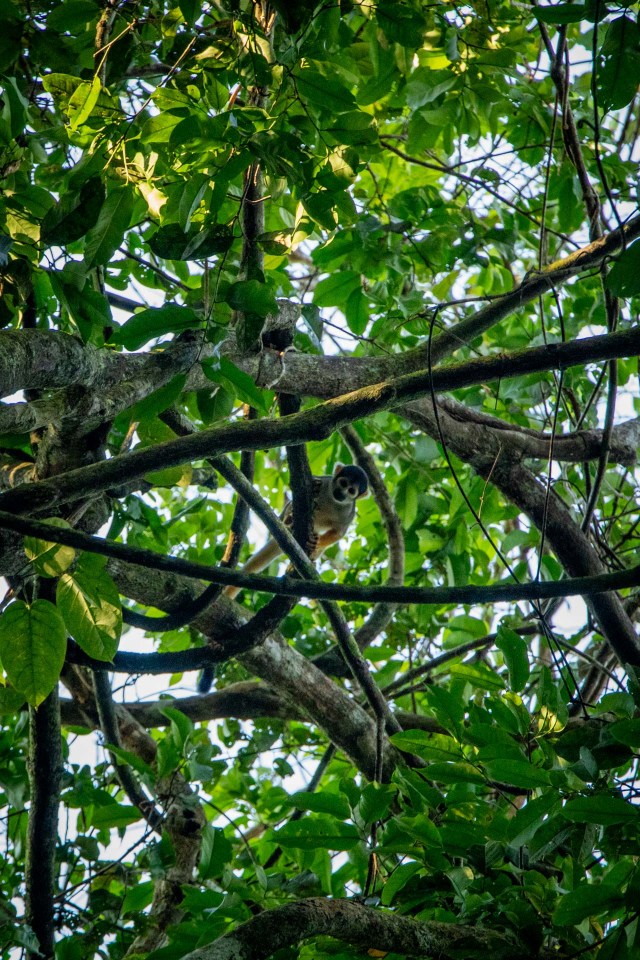 S. vanzolinii lurks in the forest. Photo: Duda Menegassi
S. vanzolinii lurks in the forest. Photo: Duda Menegassi“It is certainly the Amazonian primate species that will suffer the most drastic impacts of these changes,” stresses Renata Azevedo, coordinator of the PAN and environmental analyst at the National Center for Research and Conservation of Brazilian Primates (CPB/ICMBio).
In the second cycle, the group maintained a specific objective focused on understanding the impacts of climate change and developing mitigation strategies, says the researcher. “And especially for S. vanzolinii, there is an action to develop a contingency plan for emergency action to mitigate the impacts of extreme events (fires, floods, droughts),” explains Azevedo.
The group of experts will also discuss the need to establish a backup population for the species in captivity. Currently, not a single S. vanzolinii is held in captivity for research and conservation purposes.
Documenting the end
Brazil, home to the greatest primate diversity in the world, already has over 20% of its primates threatened with extinction – mostly due to deforestation, hunting, wildlife trafficking and habitat fragmentation. Other species also suffer from diseases, roadkill, or competition with invaders. Although challenging, these are all problems that can be addressed by public policies and local, regional, or national initiatives.
But for S. vanzolinii, the threat is global: climate change.
“This is the big issue with S. vanzolinii. Because the species is not actually threatened by the factors we normally encounter, such as deforestation and hunting… This species is threatened because of its restricted distribution and climate change. And in this regard, we can see few possibilities for managing the conservation of the species,” says Rafael Rabelo.
“Honestly,” he admits, “nowadays I think the best we can do is document this extinction process and learn from it, so we’re better prepared to protect other species in similar situations.”
For researcher Anamélia Jesus, the feeling is one of powerlessness. “For me, personally, it’s the helplessness of being a scientist facing climate change. The changes are happening faster than science itself can keep up. Faster than we can discover new species or find solutions to stop, slow down, or postpone the end of the world”.
This story was originally published in Portuguese in partnership with InfoAmazonia for the development of the StoryMap. The translation to English was done with the assistance of Artificial Intelligence, with final review by a human. For this story, the review was done by the reporter Duda Menegassi
